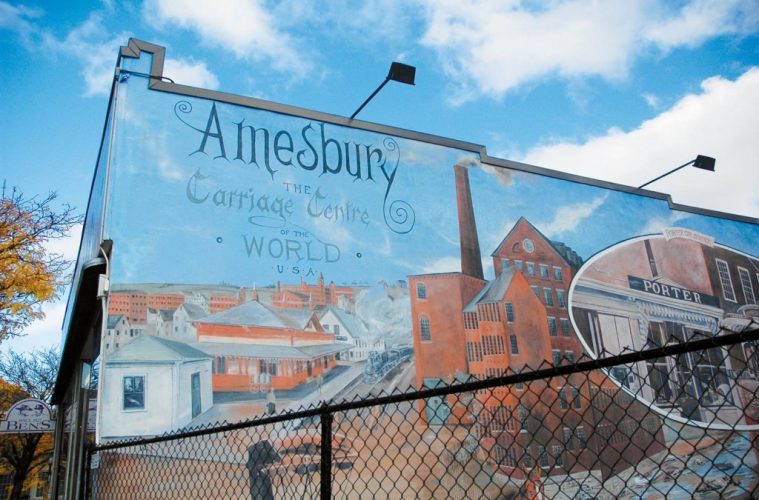In Amesbury, good things come in small packages.
Amesbury is one of those small cities that seem to fly below the radar. Sitting just south of big, bustling Portsmouth and a smidge north of tiny-but-hip Newburyport, Amesbury will surprise you. You may well have one of those “Why haven’t I come here before?” moments, as you dig into a wonderful meal at Crave Brasserie & Wine Bar, set in an old train station, or sip a caramel apple martini at Barking Dog. The city’s vibe is friendly and homey, as evidenced by a restaurateur who directed us to a competitor when we arrived at her place just after closing time. “They’ll treat you right over there!” she said.
“Amesbury feels like a small town, even though it’s a city of 16,000 people,” says chocolatier Antoinette Whitney, who works at Ovedia Artisan Chocolates on Main Street. There’s a lot going on in town, and a great mix of businesses, she adds, “but everything is a little bit tucked away, so you may need to wander down a side street to find them.”
That is true. Perhaps the best way to discover Amesbury’s charms is to park a car—not a challenge here—and, suitably bundled up, take to the streets and let the city reveal itself. The first thing you’ll notice are the big murals depicting “Carriagetown”—yes, that was Amesbury. From the 1830s to the early 1900s, the city was a big name in the carriage trade.
Wheelwrights, metal workers, draftsmen, painters, woodworkers, upholsterers, and blacksmiths all worked to create Amesbury carriages, which were among the finest in the world. More than 100 businesses were engaged in the carriage trade during the boom years, a fact that will be celebrated here with the opening of the Amesbury Carriage Museum on Water Street later this year. Ultimately, Americans shifted their transport mode from carriages to automobiles, and in 1853, Amesbury became famous for making the first electric car (who knew?). Later, from 1895 to 1932, the city was known as a major producer of automobile body parts, a business that met its demise during the Great Depression.
You’ll also notice another colorful mural in town—hard to miss, because it looks like a giant comic strip—featuring the work of cartoonist Al Capp. Capp created the iconic “Li’l Abner” comic strip from 1934 to 1977, which ran in more than 900 newspapers, and the artist has close ties to Amesbury. Capp married a local woman, Catherine Wingate Cameron, and lived nearby; the couple is buried in Mt. Prospect Cemetery on Elm Street. (Fun fact: Capp created Sadie Hawkins Day, “a pseudo-holiday when girls chase boys,” according to a plaque at the Al Capp Amphitheater in the mill yard.)
Here’s another bit of Amesbury trivia you will discover by poking around a bit: The city was once famous for hats. Tucked away in a corner of the Salisbury Point Railroad Historical Society Display at 9 Water Street is “The Hattery,” a sampling of high-fashion headgear created by the Merrimac Hat Factory. This local business was the largest maker of hats in the U.S. in 1946, ultimately closing its doors in 1971 after hats had fallen out of fashion.
One of Amebury’s major trades, boat building, continues to this day. Lowell’s Boat Shop, founded in 1793, is the oldest continually operating boat shop in the country. Even now, skilled craftsmen build dories and skiffs that were once the mainstay of New England’s fishing industry and are still used today by Gloucester fishermen. Located on the banks of the Merrimack River, Lowell’s Boat Shop is a working museum and national landmark, dedicated to preserving and perpetuating the craft of wooden boat building. Guided tours, workshops, and events are offered throughout the year.
Of course, what made all these industries run was water. Although Amesbury isn’t on the coast, there’s plenty of water here: There are three public lakes in the area, and the Merrimack and Powwow rivers wind through the city. The Powwow’s 90-foot drop over a quarter mile powered the factories that once ran in the brick mill buildings.
Now, the historic mill buildings in the center of downtown are being revitalized to house retail stores, artists, and small businesses. The Cedar Street mill building has come alive with artists’ studios, which inject cultural life into this city. The annual Open Studio Tour, held in November, featured more than 70 artists and performers last year, and the presence of young creative types has impacted the mix of businesses in the heart of the city. Day spas like Essencia and a clothing store called Real Bodies, featuring items from Bali, sit alongside local institutions like W. E. Fuller & Co., a haberdashery that dates back to 1900. And, in a sure sign that the town has a dollop of hip, there’s the Riverwalk, a converted multi-use rail trail, which runs for 1.3 miles along the Powwow River and the old Boston & Maine rail bed. If all goes according to plan, the Riverwalk will be part of a 30-mile network of rail trails that will link the city with neighboring Salisbury and Newburyport.
For now, though, the greenway goes through downtown Amesbury—which isn’t a bad place to be.
The Details
Date of Settlement: 1642. Date of Incorporation: 1668. Zip code: 01913. Population: 16,283. Total area: 13.7 sq. miles. Median household income: $66,267. Schools: Amesbury Elementary School, Cashman Elementary School, Amesbury Middle School, Amesbury High School, Amesbury Academy Charter Public High School, Sparhawk School (a private school for grades K-12). Notable residents: Josiah Bartlett, signer of the Declaration of Independence/first governor of NH; Nathaniel Currier, lithographer; Mary Baker Eddy, founder of Christian Science; Robert Frost, poet; Susannah North Martin, victim of Salem Witch Trials; John Greenleaf Whittier, poet/editor/abolitionist.

